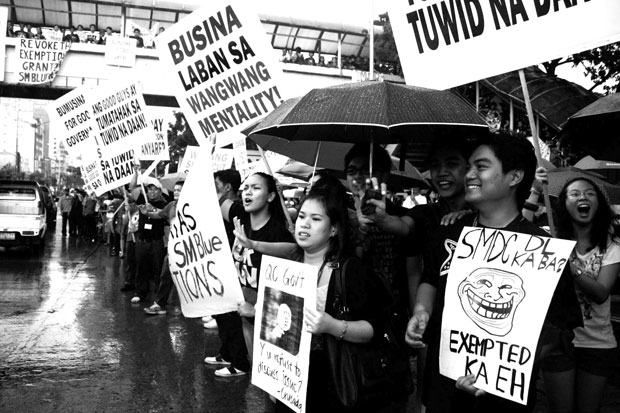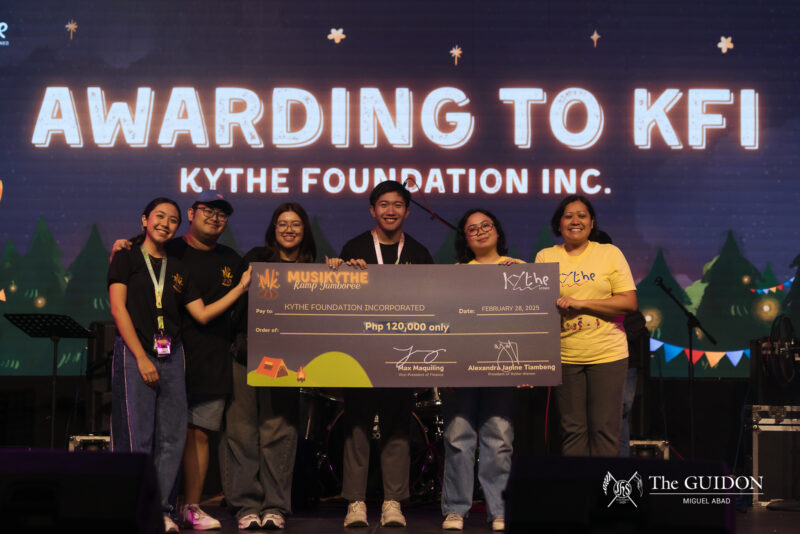
United but inconsistent. Various student leaders pointed out the good turnout at the No to SM Blue Rally, but noted the lack of consistency. Photo by Aih Mendoza
AFTER A show of protest against Shoemart Development Corporation (SMDC)’s Blue Residences project in a rally last August 12, the Loyola Heights community has been keeping up the fight through less flashy means, leading several student leaders to raise the question, “What now?”
“I don’t think the rally created awareness at all, if by awareness you mean the substantial kind that moves beyond the surface-level issue of SMDC and zoning permits,” said Steffi Sales, president of the student political science organization, The Assembly. “Yes, it was for good governance, but did everyone who participated in the rally actually understand the fundamental dynamics of the cause of good governance?”
Sales recognized that the Loyola Heights community was successful in exhorting people to join the protest, but questioned its sustainability and long-term effect.
“Where was the following through of the fight for good governance? It ended up being just like any other rally—passionately started yet abruptly ended,” she said.
The hour-long protest, dubbed a “rally for good governance,” was held last August 12 in front of Ateneo Gate 2.5, with around a hundred representatives from the Ateneo, Miriam College, and the Loyola Heights villages lending their support.
Student leaders sound off
Meanwhile, Christian Union for Socialist and Democratic Advancement (Crusada) Secretary-General Bian Villanueva said that the rally demonstrated the Loyola Heights community’s unity. However, he also expressed the need for consistency. “I think what we need now [is the] consistency in our message [and] in our actions [because] after the rally, nothing happened,” he said. “People were left wondering. The rally was able to drum up support but it wasn’t able to drum up enough visibility.”
For Sanggunian President Drew Copuyoc, however, the rally met the goals of the community, which was to spread awareness about the issue.
The community is protesting the rise of SMDC’s 42-story condominium due to the company’s alleged “shortcuts” in obtaining the legal permits necessary to construct the building. In particular, the community is complaining against the lack of consultation with the stakeholders before the permits were granted.
“For me, the success of the rally does not depend on whether or not the revocation is approved. It [depends on the awareness] of the moral pressure we have begotten to them. It’s not a short-term thing,” Copuyoc countered.
“Was there ever a rally… [where] you got what you pushed for [right] after the rally?” he asked.
Council of Organizations of the Ateneo President Kenneth Abante also said that the rally for good governance was one of the biggest and most organized mass protests the Ateneo has ever held.
Ateneo Christian Life Community (ACLC) Education Coordinator Filbert Tiu added that making an impact, big or small, was the most important achievement of the rally.
“It’s rare for Ateneans to get involved in the barangay and local issues. I don’t think Ateneans are known for rallying. [But] the fact that we are actually going out, making some noise, [is] really something to look at here,” Tiu said.
Lacking numbers
Although some representatives were satisfied with the show of the community’s unified stand against the project, some representatives voiced out concerns about the turnout of supporters.
“If it wasn’t for the non-teaching staff [of Ateneo and Miriam], there would not be so many present in the rally,” said Xavierville II representative Esther Pacheco.
The rally had been in the planning stages for several weeks, but despite the fact that the “Revoke the Zoning Exemption: No to SM Blue” Facebook page has garnered at least a thousand ‘likes,’ only more than a hundred showed up last August 12.
“We weren’t able to translate the number of ‘likes’… into the number of people who were actually [present] in the rally,” Villanueva said.
He said that while the rally showed the Loyola Heights community’s solidarity, the student turnout “could have been better.”
But Sales said that the protest against the project should be a consolidated effort of all Loyola Heights stakeholders, a sentiment echoed by the Ateneo Communications and Public Relations Head Sonia Araneta.
“It cannot survive as a student enterprise alone, especially in the context of the weakness of Ateneo campus politics,” Sales said. “Rather, it needs ties with the greater stakeholders of the Loyola Heights community, in order to get the message across and to build pressure for more dialogue between… SMDC and the city council.”
In a meeting five days after the rally, Araneta said, “It can’t just be the fight of Ateneo and Miriam. We need to lock in. We need to have the numbers.”
The post-rally meeting was held at the university president’s boardroom in Xavier Hall last August 17.
Post-rally silence
Tiu noted that both SMDC and the Quezon City Council had been silent after the mass protest.
“Not much progress has been made after the rally. Somehow, the local city councilors were pretty quiet. There was no memo, no response, [not] even from SMDC. It’s as if they didn’t hear anything after the rally,” he said.
The Loyola Heights community, meanwhile, took to the media to drum up public awareness and support, with a letter to the editor on the issue published in the Philippine Daily Inquirer last September 15. In the letter, entitled “SMDC got exemption sans consultation,” Pacheco listed their counter-arguments against an advertisement placed by SMDC in the paper last August 12. The ad was the company’s response to the community’s claims.
In the wake of the silence of the implicated parties after the protest, Sales reiterated the need for a more concentrated student action.
“In retrospect, it is this very realization of the nature of corporations and how much they belittle student action that must move students even more to further question and challenge such a status quo,” she said.







